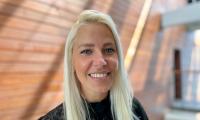Line Louise Jensen
DARE Fellowship: On the track of a mental retardation
Line Louise Jensen aims to investigate whether a dysfunction in neural circuits in the brain may be one of the factors contributing to fragile X syndrome.
Around ten children are born with fragile X syndrome (FXS) in Denmark every year.
The disease is caused by a mutation in a gene (FMR1), and FXS is the most common type of hereditary mental retardation we know.
Twice as many boys as girls are affected by FXS. Cases are typically more severe in boys, and children are usually diagnosed when they are around three or four years old.
FXS does not have a “standard version”. However, a delay in linguistic and motor development is common, as are learning difficulties and problems in eliminating irrelevant sensory input. This makes it difficult for sufferers to distinguish between important and unimportant information.
In boys, in particular, FXS produces varying degrees of mental retardation, and neuropsychiatric issues such as autism may also be part of the overall picture.
During her DARE secondment at Stanford University, Line Louise Jensen, who is studying medicine at Aarhus University and has one and a half years left before she graduates as a doctor, will investigate a hypothesis about the cause of the cognitive impairment seen in FXS.
‘I’ll be working in the laboratory of my American mentor, Lu Chen, who’s a professor of neurosurgery, psychiatry and behavioural science at the Stanford School of Medicine,’ Line, 28, explains.
The theory is that cognitive impairment related to FXS may be linked to dysfunction in a mechanism that ensures the overall stability of the neural circuits in the brain:
‘And it may be that this dysfunction disrupts another mechanism in the brain that plays a key role in learning, memory and functional development, among other things. We don’t know for sure whether this is the case in FXS, but this is what I’ll be working with my American supervisor and one of her PhD students to try to understand.’
Line Louise Jensen and her colleagues will use organoids – so-called mini organs derived from human cells – as a model system for their work. The human cells they will work with are stem cells taken from FXS sufferers. Based on this material, the researchers can produce cell structures able in many ways to mimic the biological conditions of the human body.
‘This enables us to create a model system that we can use to examine the characteristics thought to be the cause of a particular issue,’ says Line Louise Jensen.
Once the organoids have been generated – and they are so small that they can only be seen under a microscope – Line Louise Jensen will use a special technique to cut some of these structures into ultra-thin slices. Each slice is merely a few thousandths of a millimetre thick, and when the slices are dyed, the scientists can search for defects under the microscope.
Most FXS studies are conducted using animal models: ‘So this is where our approach is slightly different. But we’ll be conducting similar experiments with mice simultaneously, and this will enable us to identify FXS impairments specific to humans,’ says Line Louise Jensen.
Line’s Danish mentor is Professor Jens Randel Nyengaard from Aarhus University and Skejby University Hospital.
